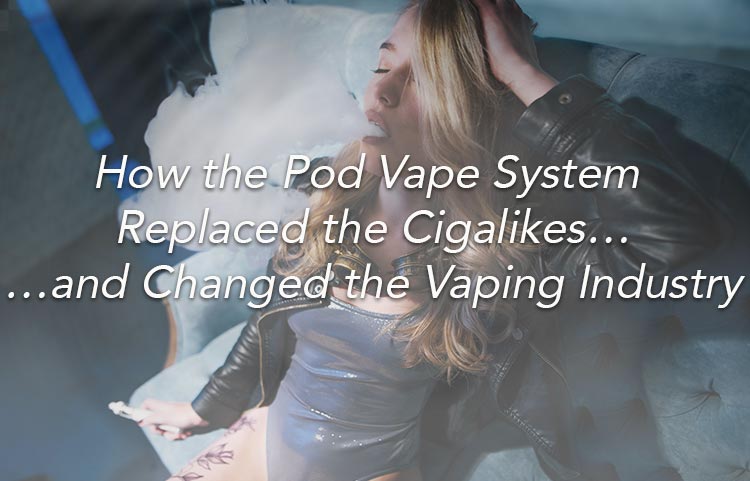Table of Contents
Last Updated on August 7, 2019 by Team Spinfuel
…and Changed the Vaping Industry
Since its launch in 2015, the JUUL pod vape system has changed virtually everything about the American mainstream vaping industry. The JUUL brand now claims about 76 percent of sales in traditional retail outlets.
Every major manufacturer in the vaping industry has at least one pod system available, and many long-term vapers have even latched on to the pod system trend and ditched their old sub-ohm mods. What happened? How did the pod system change everything? That’s what we’re going to examine in this retrospective of the past few years of vaping history.

Pod Systems Were Designed From Scratch
The pod system represents one of the first real attempts to design a simple vaping device for beginners without using the tobacco cigarette as a point of reference and without simply sourcing an already available e-cigarette kit from a white-label manufacturer in China. For years, e-cigarette reviewers told newbies that the less a vaping device looked like a tobacco cigarette, the better the device would probably work.
With pod systems, vaping product manufacturers finally stopped trying to cram a usable vaping system into a cigarette-shaped tube. The result was an infinitely better vaping experience for newbies. Paul Hunt of V2 Cigs UK says,, “Our long-term customers continue to buy the cigalike supplies that they always have, but pod systems have increasingly become the go-to devices for new vapers. We do our best to maintain a good selection of both types of devices.”
Pod Vape Systems Delivered Massively More Nicotine
Before the rise of the pod system, the nicotine strengths of most vaping devices topped out at around 18 mg. The Vuse e-cigarette was an exception with a nicotine strength of 48 mg. The JUUL, meanwhile, debuted with a whopping nicotine strength of 59 mg and a handy chart showing that it produced around the same blood-nicotine level as a tobacco cigarette.
Every vaping reviewer mentioned that chart when writing about the JUUL, and before long, every prospective vaper on the planet knew that if you wanted a vaping device that would satisfy you as much as a cigarette, you needed to buy a JUUL. Suddenly, it was possible to switch to vaping without an uncomfortable phase of adjusting to lower nicotine levels.
Nicotine Salts Provided a Better High-Nicotine Vaping Experience
One of the reasons why the Vuse e-cigarette never became enormously successful despite the backing of Big Tobacco is the fact that many people found its flavor harsh and unpleasant. One of the major changes brought about by the JUUL e-cigarette was the introduction of a new nicotine salt e-liquid formulation, which PAX Labs – the creator of the JUUL – patented.
Although early marketing language suggesting that nicotine salt was more like natural tobacco was perhaps a bit exaggerated, the fact was that the higher-nicotine salt-based e-liquid was much easier to inhale than regular e-liquid at high nicotine strengths. Finally, people who needed more nicotine could get it without a side order of throat irritation. Nicotine salt e-liquid has since become popular throughout the vaping industry and may one day become more common than freebase nicotine e-liquid.
Pod Vape Systems Had a Strong Online Marketing Push
The success of pod vaping systems really was a case of a rising tide – JUUL – lifting all boats. JUUL launched with a huge budget, an affiliate program with attractive terms and a social media influencer campaign the likes of which the vaping industry had never seen. Some – such as researchers from Stanford– have even alleged that JUUL went a bit too far with their social media marketing, creating a brand image so youthful and hip that non-tobacco users – even underage ones – were encouraged to take up vaping.
Critics and Media
Following an enormous amount of criticism and media attention – and even a federal government inquiry – JUUL has changed its course and now features images of older smokers in its advertising. By the time that change came about, though, JUUL had already transformed the American vaping industry.
Pod vapes were everywhere, and since virtually all vaping consumers were aware of the JUUL, it was possible to use that product as a basis for comparison. Vape shops everywhere began to stock their shelves with pod systems, and employees of those shops could always begin their sales pitches with “It’s like the JUUL, but…”
Pod Vape Systems Were Sleek and Stylish
When e-cigarettes first appeared on the market, they had a very cigarette-like appearance. That was important at first because not all smokers knew what vaping was yet. The cigarette-like appearance of early vaping devices provided a visual cue that those devices related somehow to smoking. “Oh, is that one of those electronic cigarette things that I’ve read about online? It looks simple enough. Maybe I’ll give it a try.”
By the time pod vape systems appeared on the market, though, smokers no longer needed a cigarette-like shape as a visual cue to identify a vaping device. Vaping product manufacturers were free to make their devices look like anything. Before long, we didn’t just have pod systems that looked like USB sticks. We also had pod systems that looked like teardrops, badges, miniature box mods and more. The more visually appealing pod systems looked, the more people wanted to try them. Next to a device like the Suorin Drop or the Lost Vape Orion, a cigalike looks positively ancient.
FDA Regulation Prevented the Launch of New Cigalikes
The obvious answer to the problem of cigalikes looking outdated is to release a new and more modern cigalike.
In the United States, though, that isn’t possible. When the FDA stepped in and announced its regulations for the vaping industry on August 8, 2016, they froze the market as it was on that date. Under the current regulations, it is no longer possible to release a new vaping product in the United States without pre-market authorization from the FDA.
With that limitation in effect, cigalike brands soldiered on in the U.S. for as long as they could before finally folding one by one. You can still find cigalikes in many convenience stores, gas stations and pharmacies, but you’ll find them next to much larger and flashier JUUL displays.
Guess which product people choose 76 percent of the time?








